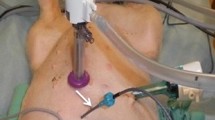Abstract
Background: The cytotoxic effect of several anticancer agents, including doxorubicin, can be enhanced by hyperthermia. The purpose of this study was to evaluate the effect of hyperthermia on the pharmacokinetics, metabolism, and tissue distribution of intraperitoneal (i.p.) doxorubicin in a rodent model. Methods: Doxorubicin was given i.p. to 20 Sprague-Dawley rats at a dose of 2 mg/kg over 60 min. Rats were randomized into two groups according to the temperature of the peritoneal perfusate: group NT received normothermic (37 °C) i.p. doxorubicin; group HT received hyperthermic (43 °C) i.p. doxorubicin. During the course of i.p. chemotherapy, peritoneal fluid and blood were sampled every 10 min. At the end of the procedure, rats were sacrificed and tissue samples (liver, spleen, small bowel, omentum, bladder, diaphragm, abdominal wall, heart) were collected. Concentrations of doxorubicin and its aglycone metabolites were determined in peritoneal fluid, plasma, and tissues by HPLC. Results: No significant differences in areas under the curve (AUC) of peritoneal fluid doxorubicin and plasma doxorubicin were found between group NT and group HT. AUC ratios (AUC peritoneal fluid/AUC blood) were 87.9 for group NT and 82.9 for group HT. Group HT exhibited increased doxorubicin concentrations for all intraabdominal tissues. These differences were significant for spleen (P = 0.03), small bowel (P = 0.03), and omentum (P = 0.03). Doxorubicin aglycone was detected in plasma of both groups within the first 10 min of the procedure. There was a significant (P < 0.001) increase in plasma aglycone AUC for group HT when compared with group NT. Group HT exhibited increased aglycone concentration for all tissues. This difference was significant for liver (P < 0.001) and bladder (P < 0.001). Conclusion: Hyperthermia did not affect significantly the pharmacokinetics of i.p. doxorubicin. Tissue concentrations of doxorubicin in small bowel, omentum, and spleen were significantly increased when the drug was administered by hyperthermic i.p. perfusion. Hyperthermia increased significantly the doxorubicin aglycone concentrations in plasma, liver, and bladder.
Similar content being viewed by others
Author information
Authors and Affiliations
Additional information
Received: 14 August 1996 / Accepted: 12 May 1997
Rights and permissions
About this article
Cite this article
Jacquet, P., Averbach, A., Stuart, O. et al. Hyperthermic intraperitoneal doxorubicin: pharmacokinetics, metabolism, and tissue distribution in a rat model. Cancer Chemother Pharmacol 41, 147–154 (1997). https://doi.org/10.1007/s002800050721
Issue Date:
DOI: https://doi.org/10.1007/s002800050721




